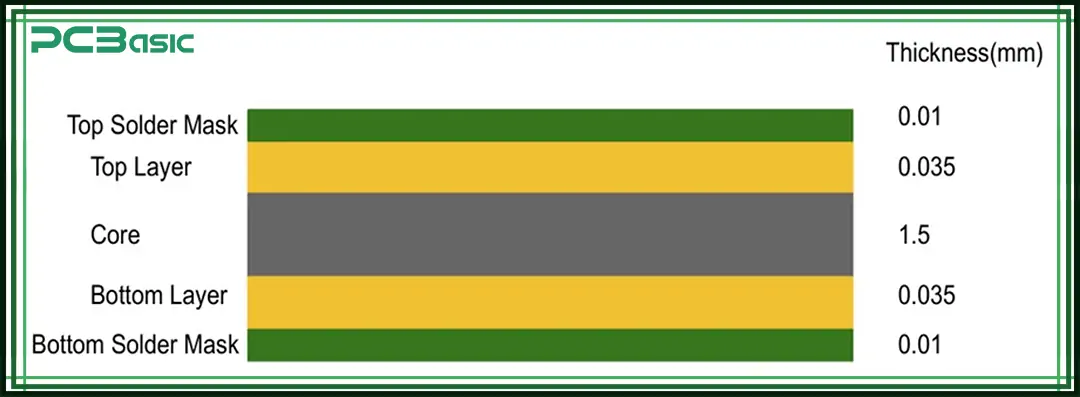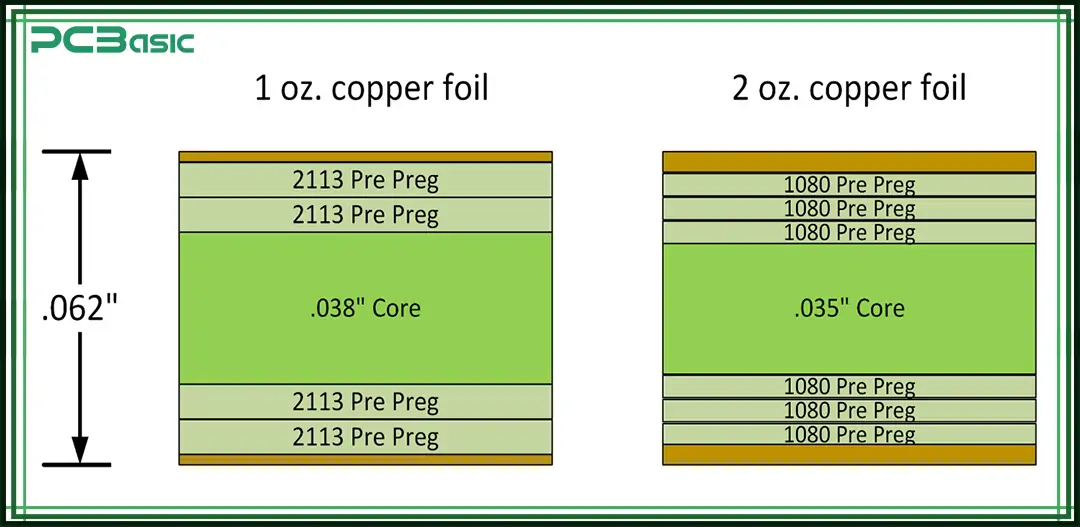Global high-mix volume high-speed Shenzhen PCBA manufacturer

Ru
9:00 -18:00, Mon. - Fri. (GMT+8)
9:00 -12:00, Sat. (GMT+8)
(Except Chinese public holidays)





Global high-mix volume high-speed Shenzhen PCBA manufacturer

Ru
9:00 -18:00, Mon. - Fri. (GMT+8)
9:00 -12:00, Sat. (GMT+8)
(Except Chinese public holidays)





HomePage > Blog > Knowledge Base > Standard PCB Thickness: What You Need to Know
A PCB thickness measurement is among the most important measurements in electronic manufacturing. You know, it affects device performance and manufacturing costs. Let's learn what PCB thickness really is.

A PCB Standard Thickness: 2 Layer PCB Stack-up
Although there is no industry standard for PCB thickness, certain thicknesses have become common.
Most PCBs are 1.6mm thick (0.063 in). That's the default thickness for everything from computer motherboards to appliances.
I'm sure you're wondering why 1.6mm? This thickness offers a good balance between strength and flexibility without costing too much. Engineers know it gives enough mechanical strength without making things too bulky.
So, you'll totally see 1.6mm most often. It's the really common thickness. But get this, PCB makers actually have a bunch of other choices too. They offer these extra options. This helps them meet specific design needs. For super thin stuff, you might see 0.4mm. This is great for flexible electronics. It's also used in tiny things like smartphones. Then there's 0.8mm.
You'll often find this one in smaller gadgets. Think smartwatches. Some medical equipment uses it too. If you're dealing with credit cards that have chips, 1.0mm is used, also, for certain portable electronics. And many everyday consumer devices use 1.2mm. This is especially when saving space is a big deal.

Of course, 1.6mm is still the standard one. Everyone goes to that for most regular uses. But what if you need something tougher? Or maybe stiffer? Makers offer 2.0mm for a bit more rigidity. Go for 2.4mm if you need extra durability. And for seriously heavy-duty jobs, you'd use thicker boards. We're talking about things like 3.2mm. These are for stuff like power supplies. Or big industrial machines that take a beating. So, you see, there's a whole range. It just depends on what your project needs!
Secondly, you need to understand how thickness relates to specific uses, such as how thick PCBs are needed for cars. Meanwhile, thin PCBs are needed for modern phones.
The thickness of a PCB correlates to its layer count and stack-up design. This is noticeable in circuit board design.
Basic 2-layer PCBs have a thickness of 1.0mm to 1.6mm. The stack-up is awesome: the core material is FR-4, with two copper layers that are soldered together, and the silkscreen is on the outside.
We still see 1.6mm PCB thickness for a 4-layer stack, but the inside structure gets more complex. There are several core layers, prepreg layers, and copper layers.

Some uses may require a 2.0mm stack-up. The six layer stack-up gets more complicated, so signal integrity is important.
The biggest mistake is when designers pick layer count without thinking about how it changes the overall thickness. While layer count and thickness are linked, it's not easy to tell since makers can adjust how thick each layer is to meet the board's thickness at the same time.
It's a challenge when making PCBs of different thicknesses. For thin boards (under 0.8mm), warping during production is an issue. Make sure your account for the manufacturing limits in your design.
PCB thickness is also influenced by the size of the panel. Most makers use standard panel sizes like 18"x24" and 18"x21", so thickness must stay consistent.
The basics are that thinner boards cost more to make because they're more complex and more likely to fail. Don't freak out about this cost increase-it usually balances out with the benefits of smaller size and lighter weight.
Different uses have different needs, so think about what you'll use, not what your PCB thickness should be.
In consumer electronics, boards are 1.0mm to 1.6mm thick. These thicknesses work well for smartphones, tablets, and home entertainment systems. Manufacturers can keep their products slim and light with 1.0mm boards. Laptops and gaming systems that need more strength can use 1.6mm boards. Engineers also know it's great for balancing heat distribution, so it doesn't overheat in compact devices.
For automotive applications, you'll need 1.6mm to 2.4mm. Cars put electronics under extreme conditions, from engine vibrations to temperature swings. Thicker boards can withstand these stresses without cracking. Engine control modules and safety systems need extra protection. 2.4mm options give them extra protection. In addition, thicker boards provide better heat dissipation under the hood. It helps handle high currents often required in automotive applications.
Aerospace might use special thicknesses based on weight and reliability needs. Spacecraft and aircraft require precision, but reliability can't be compromised. Think about how aerospace engineers balance these competing demands, and you'll get ideas on how engineers do it.
The boards of some satellite components could be thinner to save money on launch, but boards of flight-critical systems need to be thicker and more reliable. In this industry, custom thicknesses are often needed with special materials that can handle radiation, vacuum conditions, and temperature swings.
In medical devices, you may need ultra-thin boards for implant tech or standard boards for monitoring gear. It's a good idea to design thin boards (0.4-0.8mm) for implantable devices like pacemakers to reduce discomfort and improve biocompatibility. Be patient while designing these, as they need a lot of precision. A standard 1.6mm board is used for external medical monitors in hospitals. Because internal gadgets have to be miniaturized without sacrificing safety, but external gear has to handle cleaning chemicals and drops.
There are thicker boards (2.0mm to 3.2mm) for industrial equipment because factory floors are full of vibrations, dust, and chemicals. These thick boards resist physical damage and provide stability for heavier components like power transistors and large capacitors.
They're also thick enough to prevent warping under high temperatures. The robust designs mean fewer failures for PCB manufacturers, which matters for industrial applications where downtime costs thousands per minute.
Customers often have good reasons for insisting on specific thickness requirements based on their use cases, which is why it matters. You want your device to work as planned while still meeting physical constraints.
The thickness of PCBs can also affect heat management. Thicker boards can sometimes move heat better, which is good for power electronics. Thinner dielectric layers might be better for high-frequency uses.
Modern electronics run hot, and heat management is important for performance and lifespan. PCBA companies often recommend certain board thicknesses based on heat factors.
If you're designing high-power circuits, thermal testing can help you determine what board thickness works best.
Physical properties are directly affected by board thickness. Thicker boards are more rigid and can better withstand stress, while thinner boards are more flexible but can break more easily.
It's important to find the right balance between physical needs and space constraints. When you're trying to slide a PCB into a tiny case, it has to make sure it doesn't crack.
When designing flex-rigid PCBs, the thickness difference between rigid and flexible sections is crucial. PCB thickness chart guides can help engineers navigate this transition.
Signal integrity issues grow as PCBs get thinner, especially in high-speed designs. Thinner PCBs don't always work better for electrical performance.
A controlled impedance trace needs exact dielectric thickness between copper layers. This is important to keep the signal quality and prevent crosstalk.
Choose board thickness based on electrical performance needs and physical constraints. Sometimes, a slightly thicker board can handle controlled impedances better while still fitting inside the board's dimensions.
Start somewhere by checking your application's specific needs:
● Physical space limits
● Expected mechanical stress
● Heat requirements
● Electrical performance needs
● Manufacturing volume and budget
In engineering, balancing these factors takes experience. Take a look at how thickness impacts not only the board itself, but component mounting, case design, and connector placement as well.
It might look like there are endless options, but in reality, sticking with standard thicknesses (especially 1.6mm) usually delivers the best cost, performance, and manufacturing ease.
If you're making these decisions, don't just copy the specs of another design without understanding why they were made.
1.6mm remains the most popular PCB thickness across industries. Understanding how thickness, layer count, and application needs relate is key to PCB design success.
Choosing the right thickness early in the design process can save you money later. PCB manufacturers can give you useful tips on thickness selection.

Assembly Enquiry
Instant Quote